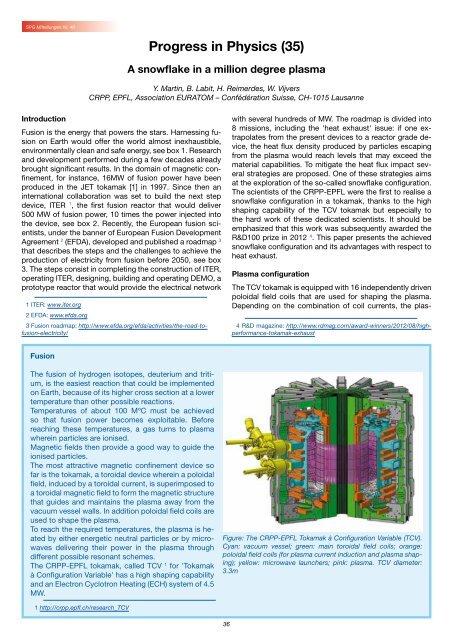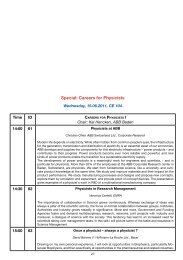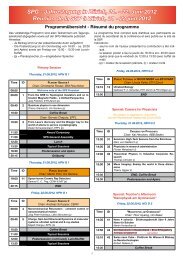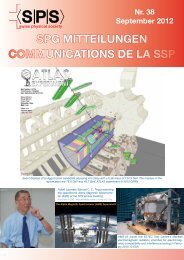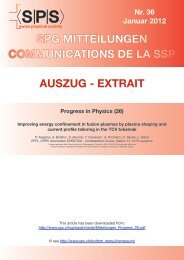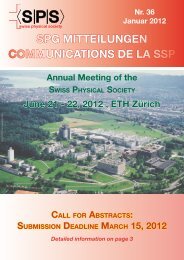spg mitteilungen communications de la ssp - Schweizerische ...
spg mitteilungen communications de la ssp - Schweizerische ...
spg mitteilungen communications de la ssp - Schweizerische ...
You also want an ePaper? Increase the reach of your titles
YUMPU automatically turns print PDFs into web optimized ePapers that Google loves.
SPG Mitteilungen Nr. 40<br />
Progress in Physics (35)<br />
A snowf<strong>la</strong>ke in a million <strong>de</strong>gree p<strong>la</strong>sma<br />
Y. Martin, B. Labit, H. Reimer<strong>de</strong>s, W. Vijvers<br />
CRPP, EPFL, Association EURATOM – Confédération Suisse, CH-1015 Lausanne<br />
Introduction<br />
Fusion is the energy that powers the stars. Harnessing fusion<br />
on Earth would offer the world almost inexhaustible,<br />
environmentally clean and safe energy, see box 1. Research<br />
and <strong>de</strong>velopment performed during a few <strong>de</strong>ca<strong>de</strong>s already<br />
brought significant results. In the domain of magnetic confinement,<br />
for instance, 16MW of fusion power have been<br />
produced in the JET tokamak [1] in 1997. Since then an<br />
international col<strong>la</strong>boration was set to build the next step<br />
<strong>de</strong>vice, ITER 1 , the first fusion reactor that would <strong>de</strong>liver<br />
500 MW of fusion power, 10 times the power injected into<br />
the <strong>de</strong>vice, see box 2. Recently, the European fusion scientists,<br />
un<strong>de</strong>r the banner of European Fusion Development<br />
Agreement 2 (EFDA), <strong>de</strong>veloped and published a roadmap 3<br />
that <strong>de</strong>scribes the steps and the challenges to achieve the<br />
production of electricity from fusion before 2050, see box<br />
3. The steps consist in completing the construction of ITER,<br />
operating ITER, <strong>de</strong>signing, building and operating DEMO, a<br />
prototype reactor that would provi<strong>de</strong> the electrical network<br />
1 ITER: www.iter.org<br />
2 EFDA: www.efda.org<br />
3 Fusion roadmap: http://www.efda.org/efda/activities/the-road-tofusion-electricity/<br />
with several hundreds of MW. The roadmap is divi<strong>de</strong>d into<br />
8 missions, including the 'heat exhaust' issue: if one extrapo<strong>la</strong>tes<br />
from the present <strong>de</strong>vices to a reactor gra<strong>de</strong> <strong>de</strong>vice,<br />
the heat flux <strong>de</strong>nsity produced by particles escaping<br />
from the p<strong>la</strong>sma would reach levels that may exceed the<br />
material capabilities. To mitigate the heat flux impact several<br />
strategies are proposed. One of these strategies aims<br />
at the exploration of the so-called snowf<strong>la</strong>ke configuration.<br />
The scientists of the CRPP-EPFL were the first to realise a<br />
snowf<strong>la</strong>ke configuration in a tokamak, thanks to the high<br />
shaping capability of the TCV tokamak but especially to<br />
the hard work of these <strong>de</strong>dicated scientists. It should be<br />
emphasized that this work was subsequently awar<strong>de</strong>d the<br />
R&D100 prize in 2012 4 . This paper presents the achieved<br />
snowf<strong>la</strong>ke configuration and its advantages with respect to<br />
heat exhaust.<br />
P<strong>la</strong>sma configuration<br />
The TCV tokamak is equipped with 16 in<strong>de</strong>pen<strong>de</strong>ntly driven<br />
poloidal field coils that are used for shaping the p<strong>la</strong>sma.<br />
Depending on the combination of coil currents, the p<strong>la</strong>s-<br />
4 R&D magazine: http://www.rdmag.com/award-winners/2012/08/highperformance-tokamak-exhaust<br />
Fusion<br />
The fusion of hydrogen isotopes, <strong>de</strong>uterium and tritium,<br />
is the easiest reaction that could be implemented<br />
on Earth, because of its higher cross section at a lower<br />
temperature than other possible reactions.<br />
Temperatures of about 100 MºC must be achieved<br />
so that fusion power becomes exploitable. Before<br />
reaching these temperatures, a gas turns to p<strong>la</strong>sma<br />
wherein particles are ionised.<br />
Magnetic fields then provi<strong>de</strong> a good way to gui<strong>de</strong> the<br />
ionised particles.<br />
The most attractive magnetic confinement <strong>de</strong>vice so<br />
far is the tokamak, a toroidal <strong>de</strong>vice wherein a poloidal<br />
field, induced by a toroidal current, is superimposed to<br />
a toroidal magnetic field to form the magnetic structure<br />
that gui<strong>de</strong>s and maintains the p<strong>la</strong>sma away from the<br />
vacuum vessel walls. In addition poloidal field coils are<br />
used to shape the p<strong>la</strong>sma.<br />
To reach the required temperatures, the p<strong>la</strong>sma is heated<br />
by either energetic neutral particles or by microwaves<br />
<strong>de</strong>livering their power in the p<strong>la</strong>sma through<br />
different possible resonant schemes.<br />
The CRPP-EPFL tokamak, called TCV 1 for 'Tokamak<br />
à Configuration Variable' has a high shaping capability<br />
and an Electron Cyclotron Heating (ECH) system of 4.5<br />
MW.<br />
Figure: The CRPP-EPFL Tokamak à Configuration Variable (TCV).<br />
Cyan: vacuum vessel; green: main toroidal field coils; orange:<br />
poloidal field coils (for p<strong>la</strong>sma current induction and p<strong>la</strong>sma shaping);<br />
yellow: microwave <strong>la</strong>unchers; pink: p<strong>la</strong>sma. TCV diameter:<br />
3.3m<br />
1 http://crpp.epfl.ch/research_TCV<br />
36


